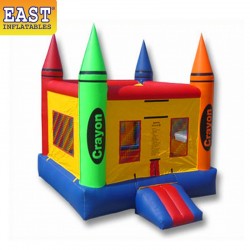
Using inflatables near water sources like pools, lakes, or rivers can enhance the fun of any event, but it comes with specific safety considerations. To ensure that your inflatable is used safely near water, follow these guidelines:
1. Verify Inflatable Specifications
First, confirm if your inflatable is designed for use near or in water. Check the manufacturer's instructions to see if the inflatable is water-resistant or suitable for wet environments. Some inflatables are intended for dry use only, while others are specifically made for water activities.
2. Ensure Proper Ground Conditions
The area around the inflatable should be stable and dry. Wet or uneven ground can affect the inflatable’s stability and lead to accidents. Ensure that the inflatable is securely anchored and that the surrounding area is free from puddles or slippery spots.
3. Keep Electrical Components Safe
Protect all electrical equipment, including blowers and extension cords, from water exposure. Water and electricity do not mix and can create dangerous conditions. Use outdoor-rated extension cords and ensure all electrical components are placed well away from water sources.
4. Address Slippery Surfaces
Water can make surfaces around the inflatable slippery, increasing the risk of slips and falls. Keep the area around the inflatable as dry as possible. If water accumulates, remove it promptly to prevent accidents.
5. Monitor Weather Conditions
Weather conditions greatly impact the safety of using inflatables near water. Avoid setting up or using the inflatable during rainy weather, strong winds, or storms. Wet conditions and high winds can compromise the inflatable’s stability and safety.
6. Supervise Users Closely
Active supervision is essential when inflatables are used near water. Ensure that there is a responsible adult supervising the area at all times. They should enforce safety rules, manage the number of users, and prevent any dangerous behavior near the inflatable.
7. Conduct Regular Inspections
Inspect the inflatable before and during use for any signs of wear or damage. Pay close attention to areas that might come into contact with water. Regularly check for any leaks, tears, or other issues that could compromise the inflatable’s integrity.
8. Prepare for Emergencies
Have a plan in place for potential emergencies. This includes knowing how to quickly deflate the inflatable if needed, having a first aid kit available, and being aware of the nearest medical facilities. Make sure all supervisors and users are informed of the emergency procedures.
Conclusion
Using inflatables near water requires careful planning and consideration. By ensuring the inflatable is suitable for wet conditions, keeping electrical components dry, maintaining a stable setup, and providing close supervision, you can help ensure a safe and enjoyable experience. Always follow safety guidelines and manufacturer recommendations to minimize risks.




Leave a Comment